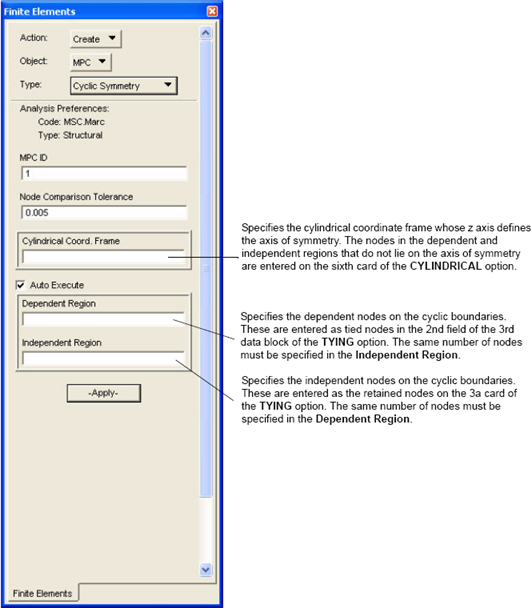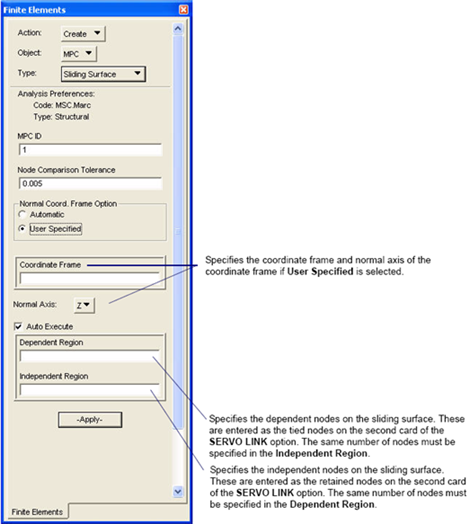

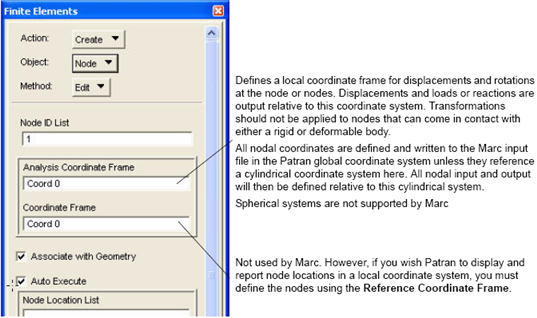
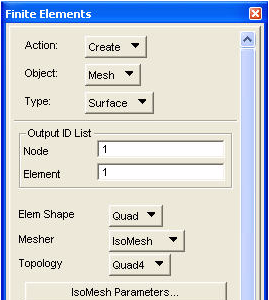
Note: | Actual Marc element types are not assigned until element properties are associated with the elements of the mesh. Care should be taken to make sure the proper element topology is used before assigning properties. For grounded springs/dampers, create point elements. |
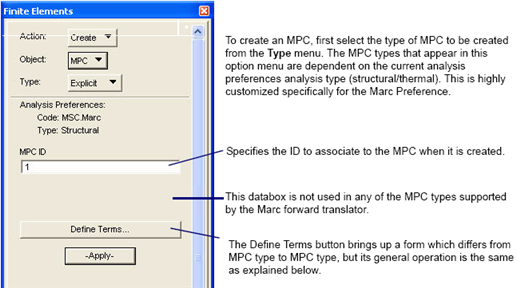
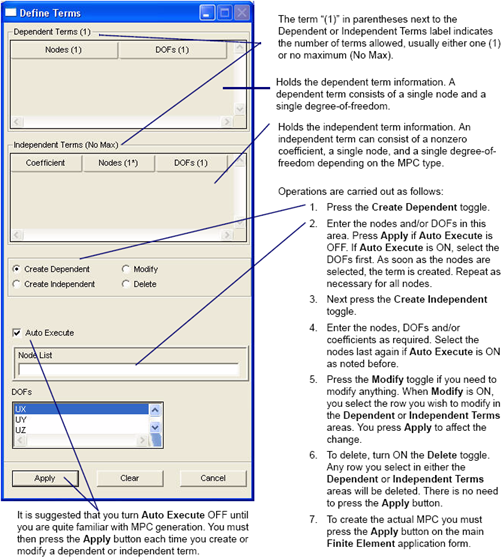
Degree-of-freedom | Analysis Type |
UX | Structural |
UY | Structural |
UZ | Structural |
RX | Structural |
RY | Structural |
RZ | Structural |
Temperature | Thermal |
Top Temperature | Thermal |
Middle Temperature | Thermal |
Bottom Temperature | Thermal |
Note: | No MPC types are defined for Coupled analysis. To use MPCs is a Coupled analysis, set the Analysis Preference to Structural or Thermal to define the MPCs you want, then set the Analysis Preference back to Coupled. Make sure that the degree-of-freedom selected for an MPC actually exists at the nodes. For example, a node that is attached only to solid structural elements will not have any rotational degrees-of-freedom. However, Patran will allow you to select rotational degrees-of-freedom at this node when defining an MPC. This may not be allowed by Marc. Marc axisymmetric have three DOFs, namely Z, R, and Theta which correspond to the X, Y, and RX DOF in the global Patran system (DOFs 1,2 and 4 respectively). |
MPC Type | Analysis Type | Description |
• Explicit | Structural Thermal Coupled | Creates a SERVO LINK explicit MPC between a dependent degree-of-freedom and one or more independent degrees-of-freedom. The dependent term consists of a node ID and a degree-of-freedom, while an independent term consists of a coefficient, a node ID, and a degree-of-freedom. An unlimited number of independent terms can be specified, while only one dependent term can be specified. |
Structural Coupled | Creates TYING Type 100 MPCs which constrains all degrees-of-freedom at one or more dependent nodes to the corresponding degrees-of-freedom at one independent node. An unlimited number of dependent terms can be specified, while only one independent term can be specified. Each term consists of a single node. | |
Structural Coupled | Creates a TYING Type 31 MPC which constrains a dependent node on one linear 2D element to two independent nodes on another linear 2D element to model a continuum. One dependent term is specified, while two independent terms are specified. Each term consists of a single node. | |
Thermal | Creates a TYING Type 87 MPC which constrains one dependent node to one independent node, which ties temperatures between shell elements. One dependent and one independent term are specified. A second independent term must be supplied but is ignored (it can be the same node). Each term consists of a single node. | |
Thermal | Creates a TYING Type 85 MPC which constrains a dependent node on one linear 2D element to two independent nodes on another linear 2D element to tie temperatures. One dependent term is specified, while two independent terms are specified. Each term consists of a single node. | |
Structural Thermal Coupled | Creates a TYING Type 33 MPC which constrains a dependent node on one linear 3D solid element to four independent nodes on another linear 3D solid element to model a continuum. One dependent term is specified, while four (three for degenerate face) independent terms must be specified. Each term consists of a single node. | |
Structural Coupled | Creates a TYING Type 32 MPC which constrains a dependent node on one quadratic 2D element to three independent nodes on another quadratic 2D element to model a continuum. One dependent term is specified, while three independent terms are specified. Each term consists of a single node. | |
Thermal | Identical to Linear Surf-Surf for Thermal analysis except a third independent term must be supplied but is also ignored. | |
• Quad. Surf-Vol | Thermal | Creates a TYING Type 86 MPC which constrains a dependent node on one quadratic 2D element to three independent nodes on another quadratic 2D element to tie temperatures. One dependent term is specified, while three independent terms are specified. Each term consists of a single node. |
Structural Thermal Coupled | Creates a TYING Type 34 MPC which constrains a dependent node on one quadratic 3D solid to eight independent nodes on another quadratic 3D solid element to model a continuum. One dependent term is specified, while eight (six for degenerate face) independent terms are specified. Each term consists of a single node. | |
• Tie DOFs | Structural Thermal Coupled | Creates a TYING Types 1-6 or 102-506 MPC which constrains two nodes at a selected degree-of-freedom or at a range of degrees-of-freedom. One dependent term is specified which consists of a single node. One independent term is specified which consists of a single node and either one or two selected degrees-of-freedom. The Marc type number will be determined by the selected degrees-of-freedom. If one degree-of-freedom is specified, a Type 1-6 MPC is created. If two degrees-of-freedom are selected, a Type 102-506 MPC is created. |
Structural Coupled | Creates a TYING Type 26 MPC which connects an axisymmetric shell element to a solid element. One dependent term is specified which consists of a single node. One independent term is specified which also consists of a single node. | |
Structural Coupled | Creates a TYING Type 49 MPC which connects triangular flat plate elements. One dependent term is specified which consists of a single node. One independent term is specified which also consists of a single node. | |
Structural Coupled | Creates a TYING Type 50 MPC which connects rectangular flat plate elements. One dependent term is specified which consists of a single node. One independent term is specified which also consists of a single node. | |
Structural Coupled | Creates a TYING Type 52 MPC which creates a pinned joint between beam elements. One dependent term is specified which consists of a single node. One independent term is specified which also consists of a single node. | |
Structural Coupled | Creates a TYING Type 53 MPC which is a full moment joint between beam elements. One dependent term is specified which consists of a single node. One independent term is specified which also consists of a single node. | |
Structural Coupled | Creates a TYING Type 80 MPC which creates a pinned rigid link between two nodes. One dependent term is specified, while two independent terms are specified. The dependent term and the first independent term are the nodes at the ends of the link, while the second independent term is an unattached node that provides the rotational information about the link. | |
Structural Coupled | Creates a TYING Type 100 MPC which ties all degrees-of-freedom between matched nodes on opposite sides of the cyclic sector. Unlimited nodes may be entered in the dependent and independent regions; however, the same number of unique nodes must be specified in both regions. | |
Structural Coupled | Creates a SERVO LINK explicit MPC which ties the normal to the surface degrees-of-freedom between matched nodes on opposite sides of the interface. Unlimited nodes may be entered in the dependent and independent regions; however, the same number of unique nodes must be specified in both regions. | |
• RBE2 | Structural | Creates an MD Nastran style RBE2 element, which defines a rigid body between an arbitrary number of nodes. Although the user can only specify one dependent term, an arbitrary number of nodes can be associated to this term. The user is also prompted to associate a list of degrees of freedom to this term. A single independent term can be specified, which consists of a single node. There is no constant term for this MPC type. The RBE parameter is also written. |
• RBE3 | Structural | Creates an MD Nastran style RBE3 element, which defines the motion of a reference node as the weighted average of the motions of a set of nodes. A finite number of dependent terms can be specified, each term consisting of a single node and a list of degrees of freedom. The first dependent (tied) term is used to define the reference node. Any (optional) dependent terms define additional nodes/degrees of freedom (dofs) that are added to the m-set. These additional dependent (tied) nodes/dofs MUST be a subset of the independent (retained) nodes/dofs as defined next. An arbitrary number of independent (retained) terms must also be specified. Each independent term consists of a constant coefficient (weighting factor), a node, and a list of degrees of freedom. All nodes with the same weighting factor and dof list should be grouped together. There is no constant term for this MPC type and at the present time, the Thermal Expansion coefficient is ignored. The RBE parameter is also written. |
Structural Thermal Coupled | Creates a TYING Type 69 MPC which is used for creating gaps or overlaps between two parts of a model either by prescribing the total force on the nodes on either side of the gap/overlap or by prescribing the size of the gap/overlap. This is typically used for pretensioning of bolts or rivets. Dependent terms contain one node each and independent terms contain two nodes each. Each dependent (tied) term consists of a node on one side of the gap/overlap. The first node of the independent (retained) term consist of the corresponding node on the other side of the gap/overlap. The second node of the independent term is a control node to which LBCs may be applied. Each independent term must have the same control node otherwise an error is issued. There must be the same number of independent vs dependent terms also, otherwise an error is issued. The control node should not be associated to any elements. In non-mechanical passes, this MPC reduces to a Type 100 between the dependent and first independent term internally to MSC.Marc. |
